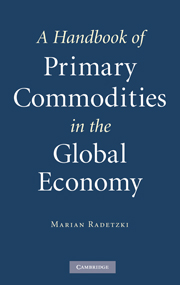Book contents
- Frontmatter
- Contents
- List of figures
- List of tables
- Acknowledgments
- Introduction
- 1 The historical framework
- 2 The geography of commodity production and trade
- 3 Comparative advantage and the trade policy distortions
- 4 Price formation and price trends in commodities
- 5 The commodity exchanges, commodity investments, and speculation
- 6 The economics of exhaustible resource depletion
- 7 Fears of, and measures to assure, supply security
- 8 Producer cartels in international commodity markets
- 9 Public ownership in primary commodity production
- 10 The monoeconomies: issues raised by heavy dependence on commodity production and exports
- References
- Index
3 - Comparative advantage and the trade policy distortions
Published online by Cambridge University Press: 23 June 2009
- Frontmatter
- Contents
- List of figures
- List of tables
- Acknowledgments
- Introduction
- 1 The historical framework
- 2 The geography of commodity production and trade
- 3 Comparative advantage and the trade policy distortions
- 4 Price formation and price trends in commodities
- 5 The commodity exchanges, commodity investments, and speculation
- 6 The economics of exhaustible resource depletion
- 7 Fears of, and measures to assure, supply security
- 8 Producer cartels in international commodity markets
- 9 Public ownership in primary commodity production
- 10 The monoeconomies: issues raised by heavy dependence on commodity production and exports
- References
- Index
Summary
Protectionism in raw materials: of great significance but mainly limited to agriculture
Protection could well be the greatest deterrent to a full realization of the potential for global economic growth and its welfare yields. The main detriment of protection is that it induces production to be located in high-cost venues. Liberalization permits production to move to its lowest-cost locations, involving savings that can be very large at times. In a recent study Kym Anderson (2004), a prominent specialist on the economics of protection, assesses the present value of the gains that could be reaped between 2010 and 2050 from the removal of one-half of existing man-made barriers to trade. Considering both the static and dynamic gains, deducting the friction costs of the proposed liberalization and applying a 5% discount rate, he comes to the stunning conclusion that the net present value of the proposed policy change would amount to some $22,000 billion (constant 2005 dollars), half of which would accrue to the developing countries. The assessed net gain can be compared to the global foreign assistance flows, which amount to less than $100 billion per year, or the global and developing country GDPs in 2005, which were assessed, using current exchange rates, at $42,400 billion and $8,800 billion, respectively (IMF, 2006b; UNCTAD, 2005). The proposed liberalization would “roughly double the annual increment to global GDP” during the forty-year period under consideration, according to the study.
- Type
- Chapter
- Information
- A Handbook of Primary Commodities in the Global Economy , pp. 47 - 56Publisher: Cambridge University PressPrint publication year: 2008



